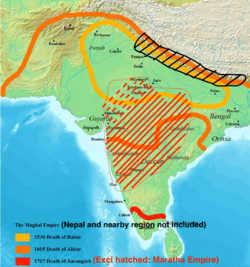Perandoria Mogule
(Përcjellë nga Dinastia Mogule)
Perandoria Mogule | |||||||||||||||||||
|---|---|---|---|---|---|---|---|---|---|---|---|---|---|---|---|---|---|---|---|
| 1526–1540 1555–1857 | |||||||||||||||||||
 Perandoria Mogule në vitin 1707 | |||||||||||||||||||
| Gjendja | Perandori | ||||||||||||||||||
| Kryeqyteti | Agra (1526–1540; 1555-1571) Fatehpur Sikri (1571–1585) Lahore (May 1586–1598) Agra (1598–1648) Shahjahanabad, Delhi (1648–1857) | ||||||||||||||||||
| Gjuhët e zakonshme | Turkikja Çagataje (vetëm fillimisht) Persishtja (gjuha zyrtare dhe e oborrito)[1] Urdishtja (e folur) | ||||||||||||||||||
| Besimi | Islami (1526–1857) Din-i Ilahi (1582–1605) | ||||||||||||||||||
| Qeveria | |||||||||||||||||||
| Lloji i qeverisjes | Monarki absolute, shtet unitar me strukturë federative | ||||||||||||||||||
| Peradnor[2] | |||||||||||||||||||
• 1526–1530 | Babur (first) | ||||||||||||||||||
• 1837–1857 | Bahadur Shah II (last) | ||||||||||||||||||
| Epoka historike | Koha e hershme moderne | ||||||||||||||||||
• Beteja e Parë e Panipatit | 21 prill 1526 | ||||||||||||||||||
• Perandoria u ndërpre nga Perandoria Sure | 1540-1555 | ||||||||||||||||||
• Vdekja e Aurangzebit | 3 mars 1707 | ||||||||||||||||||
• Rrethimi Delhit | 21 shtator 1857 | ||||||||||||||||||
| Sipërfaqja | |||||||||||||||||||
| c.1690 - 1707[a] | 4,000,000 km2 (1,500,000 sq mi) | ||||||||||||||||||
| Popullsia | |||||||||||||||||||
• 1650[b] | 145000000 | ||||||||||||||||||
| Ekonomia | |||||||||||||||||||
| Monedha | Rupi[5] | ||||||||||||||||||
| Të dhëna të tjera | |||||||||||||||||||
| |||||||||||||||||||
| Sot pjesë e | |||||||||||||||||||
Perandoria Mogule (urdisht: مغلیہ سلطنت, Mug̱ẖliyah Salṭanat),[6] të vetënjohur si Gurkanija ose Gurkani (persisht: گورکانیان, Gūrkāniyān, që do të thotë "dhëndër"),[7] ishte një perandori në subkontinentin Indian, e themeluar dhe e udhëhequr nga një dinasti myslimane e persianizuar[8][9] me origjinë çagataje turko-mongole[10][11][12] që përfshinte një pjesë të madhe të subkontinentit Indian dhe Afganistanit.
Shih edhe[Redakto | Redakto nëpërmjet kodit]
Referime[Redakto | Redakto nëpërmjet kodit]
- ^ Conan, Michel (2007). Middle East Garden Traditions: Unity and Diversity : Questions, Methods and Resources in a Multicultural Perspective, Volume 31. Washington, D.C.: Dumbarton Oaks Research Library and Collection. fq. 235. ISBN 978-0-88402-329-6.
{{cite book}}: Mungon ose është bosh parametri|language=(Ndihmë!) - ^ The title (Mirza) descends to all the sons of the family, without exception. In the Royal family it is placed after the name instead of before it, thus, Abbas Mirza and Hosfiein Mirza. Mirza is a civil title, and Khan is a military one. The title of Khan is creative, but not hereditary. pg 601 Monthly magazine and British register, Volume 34 Publisher Printed for Sir Richard Phillips, 1812 Original from Harvard University
- ^ Taagepera, Rein (1997). "Expansion and Contraction Patterns of Large Polities: Context for Russia". International Studies Quarterly. 41 (3): 500.
{{cite journal}}: Mungon ose është bosh parametri|language=(Ndihmë!) - ^ Colin McEvedy; Richard Jones (1978). Atlas of World Population History. New York: Facts on File. fq. 148.
{{cite book}}: Mungon ose është bosh parametri|language=(Ndihmë!) - ^ Richards, James (26 janar 1996). The Mughal Empire. Cambridge University Press. fq. 73–74.
{{cite book}}: Mungon ose është bosh parametri|language=(Ndihmë!) - ^ Balfour, E.G. (1976).
- ^ Zahir ud-Din Mohammad (10 September 2002).
- ^ John Walbridge.
- ^ John Barrett Kelly.
- ^ Richards, John F. (1995), The Mughal Empire, Cambridge University Press, fq. 6, ISBN 978-0-521-56603-2
{{citation}}: Mungon ose është bosh parametri|language=(Ndihmë!) - ^ Schimmel, Annemarie (2004), The Empire of the Great Mughals: History, Art and Culture, Reaktion Books, fq. 22, ISBN 978-1-86189-185-3
{{citation}}: Mungon ose është bosh parametri|language=(Ndihmë!) - ^ Balabanlilar, Lisa (15 janar 2012), Imperial Identity in Mughal Empire: Memory and Dynastic Politics in Early Modern Central Asia, I.B.Tauris, fq. 2, ISBN 978-1-84885-726-1
{{citation}}: Mungon ose është bosh parametri|language=(Ndihmë!)
| Ky article është i cunguar. Ju mund të ndihmoni Wikipedian duke e zgjeruar atë. |
